NJ Tree and Lawn Care Services by Plant Solutions:
Tree disease treatment
Insect pests and diseases weaken trees by consuming or damaging foliage, stem and root tissue. We design and deploy tree spray programs for New Jersey properties to suppress insects and diseases utilizing the latest practices of Plant Health Care (PHC). Seasonal insect monitoring ensures tree and shrub health with the safest and most efficient control method instituted at the correct time. Each visit incorporates the application of treatments designed to be most effective at various times throughout the year. Our trained PHC Technician utilizes specially designed trucks allowing us to use the most advanced, state-of-the-art tree sprayers that are environmentally safe and friendly.
Tree disease types in New Jersey
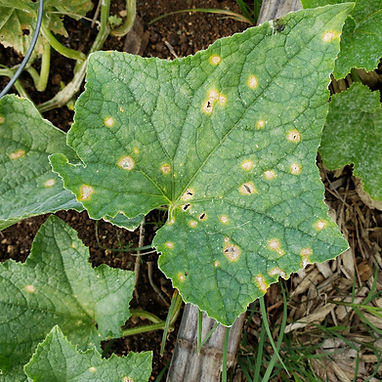
Anthracnose Disease
Anthracnose diseases are caused by fungi that are capable of infecting stems, branches, leaves and fruits of a wide variety of deciduous trees and shrubs. Sycamore, ash, maple, oak and privet are especially susceptible. The disease can be found throughout the eastern United States. The symptoms of the disease are more severe in years of extended cool, wet spring weather.
Apple Scab: Venturia Inaequilis
Apple scab occurs wherever apples are grown and may be a very serious disease on susceptible varities. The disease can also infect crabapple and mountain ash. Scab diseases similar to apple scab occur on pear, firethorn, and hawthorne. The scab-like leaf spots and fruit spots, from which the name was developed, may cause defoliation and reduction in fruit quantity and quality.

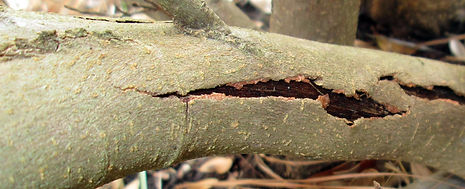
Bark splitting on trees
Bark splitting can occur in response to various environmental factors at different times of the year. Splits can occur on the trunk of the tree as well as on branches. Trees which are most susceptible to this type of injury are those which are thin-barked, such as certain fruit trees. Newly-planted trees or young trees are more prone to bark-splitting. Bark splits are not likely to be fatal to trees, although they will, in some cases, allow entry of disease organisms which can cause decay.
Black Knot: Aplosporina Morbosa
Black knot disease occurs on numerous cultivated and wild plums, prunes, and cherries. The disease is characterized by the presence of warty, black galls which may vary in size from 1/2 inch to more that 1 foot in length. The grotesque galls draw the attention from homeowners who want to improve the unsightly appearance of affected landscape trees. Black knot only affects certain types of trees, but once it takes hold, it can claim an entire tree within a couple of years.

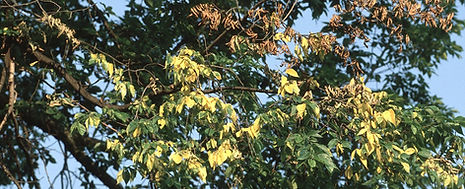
Dutch Elm Disease: Ophiostoma Novo-Ulmi
Dutch Elm Disease has been a devastating event in the history of tree diseases. It is caused by the fungi Ophiostoma novo-ulmi and O. ulmi and is vectored by bark beetles. The disease is referred to as “Dutch” Elm Disease because it was first described in Holland in 1921. The pathogen originated in the orient. The disease began its destructive reign in the United States in 1930. Prior to the arrival of this pathogen, many streets and parks were graced by the upright and spreading branch structure of American Elms.
Juniper Tip Blight
Juniper tip blight, a progressive dying back of twigs and branches, can be caused by one of three fungi, Phomopsis juniperovora, Kabatina juniperi, or Sclerophoma pythiophila. These diseases are devastating to young trees and hedges; trees more than five years old are less seriously damaged. In addition to many species of juniper, arborvitae, white cedar, cypress and false-cypress are susceptible to P. juniperovora. K. juniperi infects juniper species primarily, but S. pythiophila infects needles of pines, Douglas-fir, and eastern larch, and twigs of juniper.
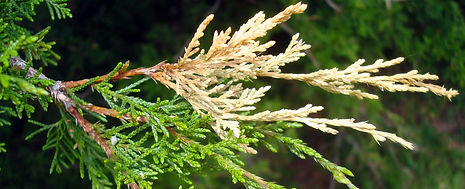
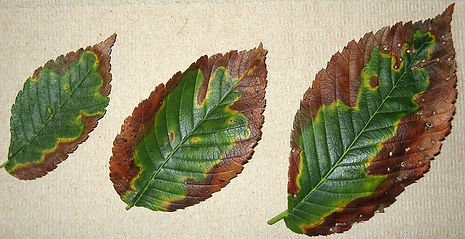
Leaf Scorch
Leaf scorch is a physiological problem that can occur on any kind of plant. It can be caused by transplanting, soil compaction, nearby excavation, a nutrient deficiency, chemical injury, unfavorable weather conditions (such as drought), poor soil, or limited room for root growth. Scorch often occurs in July and August, especially on newly planted trees, when the roots cannot supply enough water to offset the water lost through the leaves in transpiration. Hot, dry winds will increase the amount and severity of leaf scorch, especially in the early summer after a cool, wet period.
Powdery Mildew
There are numerous fungi that fall under the general description of a powdery mildew. They will be treated together here since most of these have similar habits and similar management practices. Houseplants that are commonly infected by powdery mildew include African violet and begonia. Outdoors there are numerous plants that may be infected in any year, but lilac, phlox, some rose varieties and fruit trees seem to be infected most frequently.
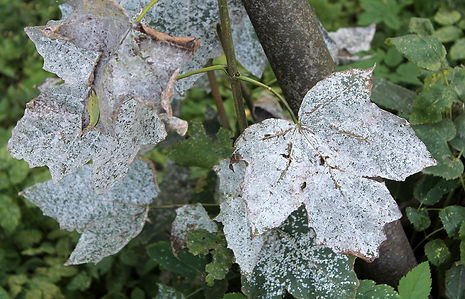
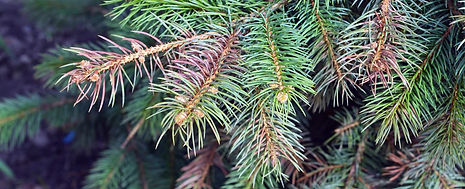
Spruce Canker
Many frequently encountered twig and branch killing disease of ornamental, forest, and fruit trees are caused by fungi of the genera Cytospora and Leucocytospora. Many species of these fungi cause cankers on scaffold branches or young tree trunks in addition to twig dieback. The appearance, spread, and control of these twig diebacks and cankers are similar.



